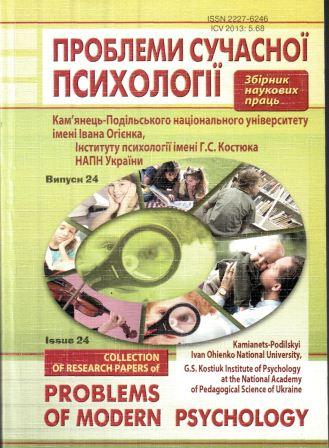Вплив професійної ідентифікації працівника на організаційний клімат.
DOI:
https://doi.org/10.32626/2227-6246.2014-24.%25pКлючові слова:
професійна ідентифікація працівника (ідентифікація з професією, організацією, робочими колективом та керівником), організаційний клімат, статус організації.Анотація
Здійснено аналіз взаємозв’язку професійної іденти-
фікації працівника (ідентифікації з професією, організацією, робочими
колективом та керівником) з різними аспектами організаційного клі-
мату в традиційних організаціях. Результати показують, що ідентифі-
кація співробітника з організацією залежить від таких аспектів органі-
заційного клімату, як відкритість до нового досвіду, інноваційність та
гнучкість. Ідентифікація працівника з керівником позитивно впливає
на такі організаційні процеси, як автономність, інтеграція, залучення
працівників до виконання завдань та добробут працівника.
Посилання
Alvesson, M. & Willmott, H. (2001). Identity Regulation as
Organizational Control: Producing the Appropriate Individual//
Institute of Economic Research Working Paper Series. – РР. 1-32.
Aust P. (2004). Communicated values as indicators of
organizational identity: A method for organizational assessment
and its application in a case study // Communication Studies. –
(4). – РР. 515-534.
Ashforth, B. E., & Johnson, S. A. (2001). Which hat to wear?
The relative salience of multiple identities in organizational
contexts. In M. A. Hogg & D. J. Terry (Eds.), Social identity
processes in organizational contexts. Philadelphia: Psychology
Press. – РР. 31–48.
Ashforth, B., Harrison, S. and Corley, K. (2008). Identification
in Organizations: An Examination of Four Fundamental
Questions // Journal of Management. – 34(3). – РР. 325-374.
Barreto M., Ellemers, N. (2003). The effects of being
categorized: The interplay between internal and external social
identities // European Review of Social Psychology. – 14. –
РР. 139-170.
Cheney, G. & Christensen, L. T. (2001). Organizational Identity:
Linkages Between Internal and External Communication.
In F. M. Jablin & L. L. Putnam (Eds.), The New Handbook of
Organizational Communication: Advances in Theory, Research,
and Method. – Sage: Thousand Oaks, CA. – РР. 231–261.
Cicero L., Pierro A., van Knippenberg, D. (2007). Leader Group
Prototypicality and Job Satisfaction: The Moderating Role of
Job Stress and Team Identification. Group Dynamics: Theory,
Research, and Practice, 11(3). – РР. 165–175.
Dutton, J. E., Dukerich, J. M., & Harquail, C. V. (1994).
Organizational images and member identification//
Administrative Science Quarterly. – 39. – РР. 239–263.
Hewstone M., Martin R., Hammer-Hewstone C., Crisp R. J.,
Voci, A. Majority-minority relations in organizations:
Challenges and opportunities. In M. A. Hogg & D. J. Terry
(Eds), Social identity processes in organizational contexts.
Philadelphia, PA // Psychology Press, 2001. – РР. 67-86.
Hogg M.A., & Terry D. J. (2002) Social Identity Processes in
Organizational Contexts // Psychology Press. – 354 p.
Hogg, M. A., & Abrams, D. (1988). Social identifications: A
social psychology of intergroup relations and group processes.
London: Routledge.
Johnson, M.D., Morgeson, F.P., Ilgen, D.R., Meyer, Ch.J. and
Lloyd J.W. (2006). Multiple Professional Identities: Examining
Differences in Identification Across Work-Related Targets //
Journal of Applied Psychology. – 91(2). – РР. 498–506.
Kassing J. (1997). Articulating, antagonizing, and displacing:
A model of employee dissent // Communication Studies. –
(4). – РР. 311-332.
Loi, R., Ngo, H. Y., Foley, Sh. (2004). The effect of professional
identification on job attitudes: a study of lawyers in Hhong
Kong. Organizational Analysis. – 12(2). – РР. 109–128.
Mael F., & Ashforth, B. E. (1992). Alumni and their alma mater:
A partial test of the reformulated model of organizational identification//
Journal of Organizational Behavior. – 13. – РР. 103-123.
Ouwerkerk J., W., Ellemers, N. (2002). The benefits of being
disadvantaged: Performance-related circumstances and
consequences of intergroup comparisons // European Journal
of Social Psychology. – 32. – РР. 73-91.
Parker, C. P., Baltes, B. B., Young, S. A., Huff, J. W., Altmann,
R. A., Lacost, H. A., & Roberts, J. E. (2003). Relationships
between psychological climate perceptions and work outcomes:
A meta-analytic review // Journal of Organizational Behavior. –
– РР. 389-416.
Patterson M.G., West M.A., Shackleton V.J., Dawson J.F.,
Lawthom R., Maitlis S., Robinson D.L., Wallace A.M. (2005)
Validating the organizational climate measure: links to
managerial practices, productivity and innovation // Journal
of Organizational Behavior. – 26. – РР. 379–408.
Pierro A., Cicero L., Higgins E. T. (2009). Followers’ satisfaction
from working with group-prototypic leaders: Promotion focus
as moderator // Journal of Experimental Social Psychology. –
(5). – РР. 1105–1110.
Platow M. J., & van Knippenberg, D. (2001). A social identity
analysis of leadership endorsement: The effects of leader ingroup
prototypicality and distributive intergroup fairness. Personality
and Social Psychology Bulletin. – 27. – РР. 1508–1519.
Rhoades L., & Eisenberger. R. (2002). Perceived organizational
support: A review of the literature // Journal of Applied
Psychology. – 87. – РР. 698-714.
Rosch E. (1978). Principles of categorization. In E. Rosch & B.
B. Lloyd (Eds.), Cognition and categorization. Hillsdale, NJ:
Erlbaum.
Van Knippenberg D., & Hogg, M. A. (Eds.) (2003). Leadership
and power: Identity processes in group and organizations.
London: Sage.
##submission.downloads##
Як цитувати
Номер
Розділ
Ліцензія
Редакція має повне право публікувати у Збірнику оригінальні наукові статті як результати теоретичних і експериментальних досліджень, які не знаходяться на розгляді для опублікування в інших виданнях. Автор передає редколегії Збірника права на розповсюдження електронної версії статті, а також електронної версії англомовного перекладу статті (для статей українською та російською мовою) через будь-які електронні засоби (розміщення на офіційному web-сайті Збірника, в електронних базах даних, репозитаріях та ін).
Автор публікації зберігає за собою право без узгодження з редколегією та засновниками використовувати матеріали статті: а) частково чи повністю в освітніх цілях; б) для написання власних дисертацій; в) для підготовки абстрактів, доповідей конференцій та презентацій.
Автор публікації має право розміщувати електронні копії статті (у тому числі кінцеву електронну версію, завантажену з офіційного web-сайту Збірника) на:
- персональних web-ресурсах усіх Авторів (web-сайти, web-сторінки, блоги тощо);
- web-ресурсах установ, де працюють Автори (включно з електронними інституційними репозитаріями);
- некомерційних web-ресурсах відкритого доступу (наприклад, arXiv.org).
Але в усіх випадках обов’язковою є наявність бібліографічного посилання на статтю або гіперпосилання на її електронну копію, що містяться на офіційному сайті Збірника.






